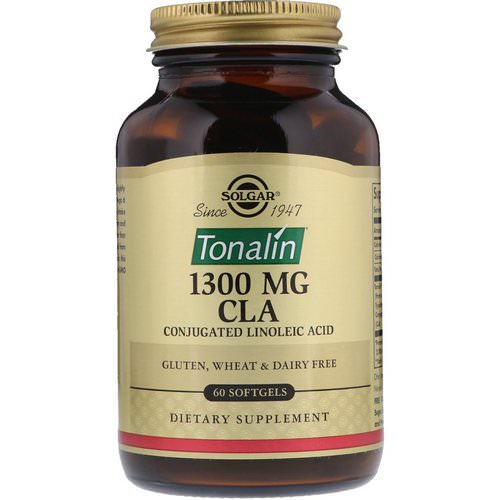Linoleic acid is an unsaturated fatty acid mainly found in plant oil. It is an essential fatty acid which cannot synthesize by body hence it should be consumed through regular diet. It is very important for human body as it is essentially required for the synthesis of prostaglandin (a hormone) required for inhibiting inflammation. Linoleic acid has also antiatherogenic activities which are associated with preventing atherosclerosis and promotes cardiac health.
It is a fatty acid with 18 carbons and contains two double bonds at 9th carbon and 12th carbon. It is liquid in room temperature and basically colorless. Replacing saturated fat with linoleic fatty acid is a healthy choice as it provides energy to body as well as helps to reduce total cholesterol level and LDL level, also helps to prevent diabetes, obesity and cardiovascular diseases. It is considered as highly consumed PUFA of human diet.
What is conjugated linoleic acid (CLA)?
Conjugated linoleic acid is the most common type of linoleic acid, which is its conjugated isomer. Basically, it is the mixture of geometric and positional isomer of linoleic acid and performs various biochemical functions of body. It helps to enhance the overall growth of the body and helps to reduce body fat percentage. It also acts as a potent anti-carcinogenic substance and helps to inhibit cancer. CLA is typically present in milk and flesh of ruminant animals. Recently, CLA is widely used as dietary fat for its potential health benefits.

Sources
Linoleic acid is naturally present in foods of both plant and animal sources. The below table will show an overview of the sources of linoleic acid –
| Plant sources | Animal sources |
|
|
Health benefits
Role on preventing inflammation
- Linoleic acid helps in the synthesis of arachidonic acid (polyunsaturated fatty acid) which is associated with synthesizing prostaglandin. Prostaglandin is a hormone which is responsible for regulating inflammation and helps to reduce the feeling of pain
- Proper regulation in the ratio of linoleic acid to linolenic acid in diet is considered as the principle factor for preventing inflammation
- It has seen that the metabolites of linoleic fatty acid have pro-inflammatory effect also. So excessive consumption of linoleic acid is not good for health as it is related with contributing low-grade inflammation

Role on preventing atherosclerosis
- Atherosclerosis is referred as a complex inflammatory disease. It is associated with formation of fibrous plaque in the arterial wall due to excessive fat deposition that leads to thrombosis
- It is mainly caused by impaired fat metabolism and maladaptive inflammatory response. It is considered as the primary causative factors of ischemic heart disease and if it is not treated properly then it would cause myocardial-infraction and death. As linoleic acid has antiatherogenic property hence consuming it is beneficial to prevent atherosclerosis and its consequences
- Saturated fatty acid is associated with increasing LDL level which is considered as another vital risk factor for developing atherosclerosis. Whereas linoleic acid helps to decrease the LDL cholesterol concentration and gradually reduces the incidence of fat deposition within blood vessels
- Linoleic acid helps to improve the ratio of HDL and LDL in body which helps to protect the heart from damages.
- It also helps to prevent the susceptibility of obesity and reduces the risk of developing cardiac problems
Role on preventing diabetes
- It has seen that linoleic acid is associated with increasing the sensitivity of insulin, which is responsible for effective regulation of blood sugar level
- Basically, it helps to prevent type 2 diabetes mellitus
Role on cell membrane

- Linoleic acid helps to produce triglyceride, cholesterol ester and phospholipids through esterification process among which phospholipids are considered as one of the most important integral part of cell membrane
- It helps to maintain the permeability and fluidity of cell membrane results in effective cellular transport, which is associated with cellular survival
Role on preventing cancer
- It has antioxidant property and helps to reduce the susceptibility of developing cancers
- It also helps to prevent lipid peroxidation hence reduces the concentration of harmful products, which have yield from this peroxidation process within body. These products interfere with cell signaling, cytotoxicity and causes severe damage to nucleic acid which is responsible for providing carcinogenic effects within body.
- So, consumption of linoleic acid is beneficial to protect the body from harmful carcinogenic effect and oxidative stress
Role on endocrine system
- Linoleic acid is related with enhancing the growth and functioning of endocrine glands and helps to synthesize several hormones
- As mentioned above, linoleic acid is required for the synthesis of arachidonic acid, which is a polyunsaturated fatty acid, contains 20 carbons in its structure with four double bonds. This arachidonic acid is essentially required for synthesis of various hormones like prostaglandin, leukotrienes, thromboxanes. Hormones of these three classes are responsible for performing several important biochemical functions of body and helps in survival
- Apart from that it helps in the synthesis of decosa hexanoic acid (DHA) and helps in the growth and development of central and peripheral nervous system

General consideration of consuming linoleic acid
- As stated above, linoleic acid is an essential fatty acid and has significant health benefit hence it should be consumed daily through diet or supplements to prevent its deficiency but it should be kept in mind that excessive consumption may cause adverse effects. It may increase hypertension, water retention within body leads to oedema and associated with developing blood clots and results in strokes and heart attacks
- Whereas deficiency of linoleic acid is associated with developing scaly skin lesions, fatty liver, growth retardation, altered lipid profile, poor wound healing, increased susceptibility to infections, poor immunological responses, reproduction related problems and infertility (in extreme condition)
- It is very important to know about the daily requirement of linoleic acid for preventing the harmful consequences of its hyper or hypo-activity. Adult women should consume 11g of linoleic acid per day whereas adult men should consume 14g of lenoleic acid daily to meet its requirements. On a contrary, infant should consume 4.4g to 4.7 g linoleic acid per day and children between the age group of 1to 3 years should consume 7g of linoleic acid daily
- Linoleic acid is abundantly present in breast milk. So, deficiency of linoleic acid is very uncommon among breast fed infants but infants who cannot breast fed properly should consume linoleic acid fortified infant formulas to prevent its deficiency
- Linoleic acid can be desaturated and elongated to form arachidonic acid, which further converted into several bioactive compounds called ecosanoids. These ecosanoids are responsible for carrying out several metabolic functions of cells and tissues but excessive productions of ecosanoids are associated with developing some chronic diseases like cancers, inflammations
- Individual who want to promote the health of their skin should consume linoleic acid as it acts as a precursor for ceramines which is an important skin lipid


Source:
Bruen, R., Fitzsimons, S. and Belton, O., 2017. Atheroprotective effects of conjugated linoleic acid. British journal of clinical pharmacology, 83(1), pp.46-53.
Burns, J.L., Nakamura, M.T. and Ma, D.W., 2018. Differentiating the biological effects of linoleic acid from arachidonic acid in health and disease. Prostaglandins, Leukotrienes and Essential Fatty Acids, 135, pp.1-4.
Fuke, G. and Nornberg, J.L., 2017. Systematic evaluation on the effectiveness of conjugated linoleic acid in human health. Critical reviews in food science and nutrition, 57(1), pp.1-7.
Jandacek, R.J., 2017, June. Linoleic acid: a nutritional quandary. In Healthcare (Vol. 5, No. 2, p. 25). Multidisciplinary Digital Publishing Institute.
Kim, J.H., Kim, Y., Kim, Y.J. and Park, Y., 2016. Conjugated linoleic acid: potential health benefits as a functional food ingredient. Annual Review of Food Science and Technology, 7, pp.221-244.
Shokryazdan, P., Rajion, M.A., Meng, G.Y., Boo, L.J., Ebrahimi, M., Royan, M., Sahebi, M., Azizi, P., Abiri, R. and Jahromi, M.F., 2017. Conjugated linoleic acid: a potent fatty acid linked to animal and human health. Critical reviews in food science and nutrition, 57(13), pp.2737-2748.
Viladomiu, M., Hontecillas, R. and Bassaganya-Riera, J., 2016. Modulation of inflammation and immunity by dietary conjugated linoleic acid. European Journal of Pharmacology, 785, pp.87-95.
Yasudi, H., Kishida, S., Domoto, T. and Mitsui, T., Sunstar Inc, 2019. Composition containing linoleic acid. U.S. Patent Application 16/343,891.


